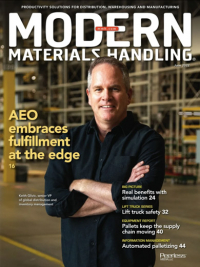American Eagle Outfitters embraces fulfillment at the edge
AEO is taking a new approach to fulfillment, especially e-fulfillment, inside and outside the four walls of its distribution centers. The focus is on speed.
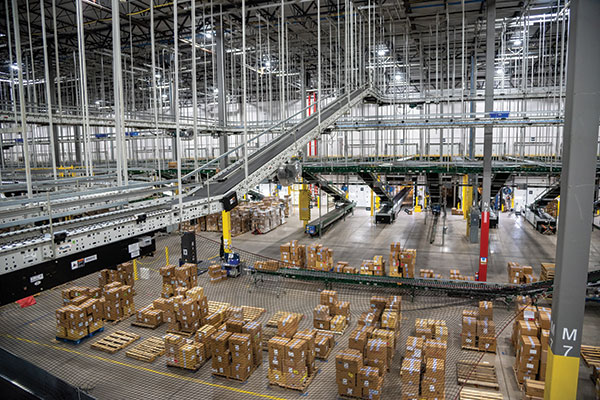
Brick-and-mortar retailers, regardless of their size, are under more pressure than ever.
That sentence has led off so many articles that it’s practically a cliché. At the same time, there’s usually some underlying truth to clichés. It’s true that retailers have been Amazoned. Thanks to Amazon, we all expect limitless product selection. Thanks to Prime, our expectation is that orders will be delivered in two days at the least, more than likely in one day, with same day around the corner. All this and at no cost to the buyer.
Keeping up with Amazon is not just stretching the little guy, it’s even stretching the capabilities of retail giants like Walmart and Target. And they have something the smaller retailers do not: Scale in all aspects of their business. They can leverage 1,000s of stores and hundreds of distribution centers. They have deep financial pockets—that’s the reason Target was able to acquire Shipt and technology from Deliv to beef up its last-mile delivery chops.
Most importantly, in a data-driven world, they have billions of transactions year in and year out: That’s important because systems driven by artificial intelligence and machine learning need data to improve. The more data, the more learning and optimization are possible. Consider this: By some estimates, each year, Walmart adds shipping volume equivalent to about the annual volume of 20 American Eagle Outfitters.
Yet, small to mid-sized retailers like AEO, with $5 billion in revenue, have to find ways to deliver the same level of customer service. These are the retailers that populate our malls, shopping centers and downtown shopping districts.
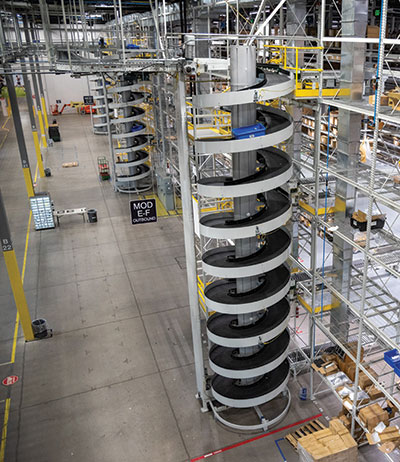
When e-commerce was a relatively small percentage of those companies’ annual sales, the expense associated with world-class fulfillment could be chalked up as a cost of doing business or a loss leader, like bargain-priced t-shirts to get customers in the door. But with the sudden acceleration of e-commerce during the pandemic, it’s not sustainable.
In the case of AEO, the specialty apparel retailer had been taking on the e-commerce boom for years with three distribution centers dedicated to omni-channel retailing. One in Ottawa, Kan, another in Hazleton, Pa., and a location in Mississauga, Ontario, for the Canadian market.
The facilities represent investments in automation for full and mixed-case store replenishment and piece picking for e-fulfillment from shared inventory across AEO’s brands. However, beginning about two years ago, under the direction of Shekar Natarajan, AEO’s chief supply chain officer, AEO has been charting a new course for its own operations and potentially of the operations of other similar-sized retailers that can share AEO’s network. It’s not exactly Fulfillment by AEO, but similar. That evolution, along with what the future might look like, is what we’ll explore over the next two issues of Modern.
From store replenishment to omni-channel
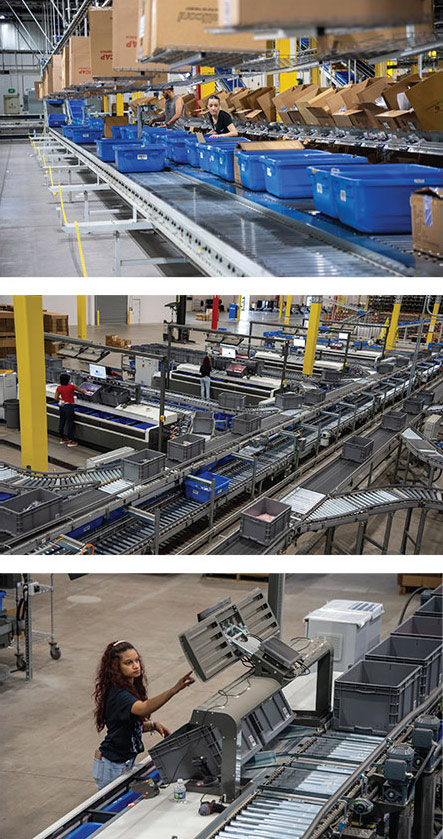
AEO’s e-fulfillment strategy is at least 15 years old. In June 2007, I visited the first mile of the journey, which was a new 525,000-square-foot, multi-channel distribution center in Ottawa, Kan. The facility was adjacent to an existing 400,000-square-foot facility that did store replenishment. It was so new at the time of my visit that AEO was still filling out the inventory in the centrally located storage area that fed the pick modules, and finalizing the reserve storage area. AEO’s other facility at the time was in Warrendale, Pa., which had also been designed to service stores, not e-commerce.
The facility was truly ahead of its time. In 2007, no one was using terms like multi-channel, omni-channel, waveless picking or warehouse execution system (WES), but those attributes are exactly what set it apart. It was designed to handle the company’s retail brands—American Eagle and Aerie; to crossdock cartons and mixed cartons; to replenish stores; and to fill direct-to-consumer (DTC) orders across the two brands. Three features set it apart.
Inventory was co-mingled in the reserve storage area to maximize storage. A pallet of American Eagle inventory might be stored in a bay directly adjacent to a pallet from Aerie if that made the best use of the space.
It used three different picking methodologies based on SKU velocity, including ring scanners, voice and pick-to-light. A horseshoe-shaped crossbelt sorter consolidated orders for packing. Those orders might be mixed case, multi-line or single-line orders.
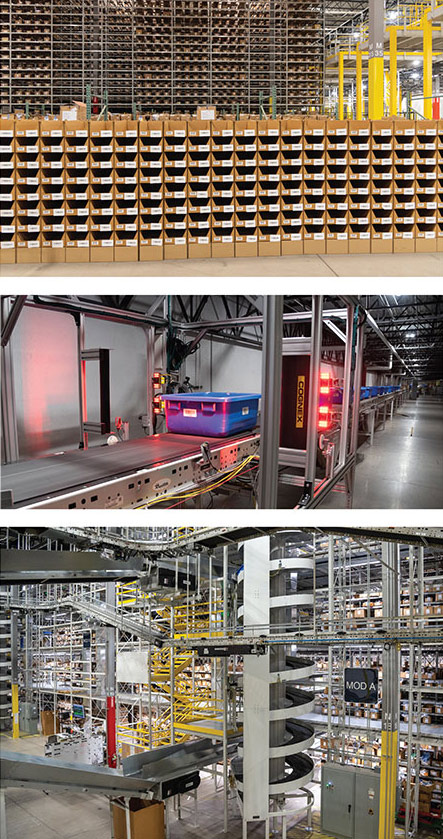
But what really set the facility apart was a unique software system from Vargo that was then called an optimization engine. Today, we’d call it a WES. In this setup, the warehouse management system (WMS) was truly a management system that managed receiving, inventory and shipping and communicated with the order management system.
The optimization engine managed order fulfillment without traditional pick waves; instead, it allocated work across the facility based on the workloads at the various picking and packing stations. The idea was to keep all of the workstations busy without overloading any one area.
AEO and Vargo believed it was the first waveless, dynamic picking solution in direct-to-consumer order fulfillment for a specialty retailer. It was certainly the first we’d seen.
The model worked for nearly a decade, with store replenishment coming from Warrendale and Ottawa, and most of the e-fulfillment from the Ottawa location. However, as early as 2011, AEO realized that the current design had to be reimagined. Amazon’s six-year-old Prime subscription service was attracting more and more subscribers and continually raising the bar on customer expectations for free and speedy delivery. It was incumbent on retailers of all sizes to grow their fulfillment capabilities. Speed to the consumer was paramount. That led to the second leg of the e-fulfillment journey.
In June 2014, AEO opened a new 1.6 million-square-foot, Silver LEED-certified, omni-channel facility in Hazleton, Pa. to replace the Warrendale facility. A number of high-level goals influenced the design of the building.
- Reduce supply chain risk: In the past, it was not uncommon for AEO to reach full capacity during peak season in Ottawa, without a backup for business continuity.
- Get closer to the customer: The new location was closer to AEO’s significant customer base on the East Coast. Proximity enabled faster turn times for customer orders.
- Create flexibility: Processes were designed so order selectors could move seamlessly from the retail picking operations to direct-to-consumer as needed.
- Enable true omni-channel retailing: With the new facility and re-designed network, AEO was able to give an online customer visibility and access to inventory in both DCs and the stores. That allowed AEO to fill an order from multiple distribution centers or the retailer’s stores.
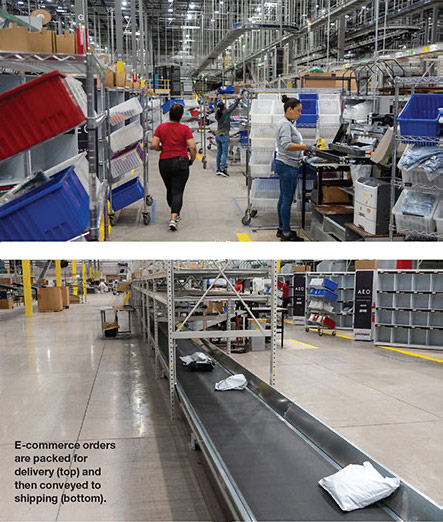
The lifeblood of the facility was an inbound conveyor and sortation system that routes incoming merchandise to where it’s needed most, whether that’s in a retail replenishment area or a direct-to-consumer fulfillment area. It also featured six four-level pick modules serviced by motor-driven roller conveyor, a large unit sorter that sends pieces to a putwall area for multi-line orders and, as in Ottawa, multiple picking methodologies, including ring scanners and put-to-light. The same WES optimization engine balanced the workload.
The new facility emphasized speed through the building and to the customer. Outside the facility, the geographic location positioned inventory much closer to AEO’s largest customer base. Inside the facility, redesigned processes improved how inventory and orders flowed through the building. For instance, newly received merchandise in Ottawa was palletized before putaway into reserve storage, and then was moved as needed to a pick module.
The Hazleton facility eliminated palletized reserve storage: New merchandise was crossdocked if possible, if not, it flowed directly to a pick module or the retail fulfillment area, eliminating at least two touches. Another innovation was to develop a flexible workforce. Associates were cross-trained so they could move from e-commerce fulfillment to store replenishment as needed. That avoided bottlenecks.
Last, the facility was built for growth, with two buildings available for expansion.
The labor challenge.
It’s hardly news that distribution centers have a labor problem. It’s in the headlines today, but distribution and logistics operations were dealing with staffing shortages and high turnover rates for years before Covid, especially at peak.
What changed during the pandemic is that more associates left the workforce, or were reluctant to work in industrial facilities, at the same time as the volume of labor-intensive e-commerce orders went through the roof, requiring even more labor than in the past.
Given its close proximity to New York City, Hazleton, Pa., was one of the hardest hit areas in the early days of the pandemic. AEO made employee engagement a priority.
“Years ago, automation was the solution for labor issues,” Glivic says. “Today, the question is: How do we assist our employees? Moving forward, that’s our filter: Whatever we bring in has to be flexible to grow with us and make the job easier.”
One of the tools introduced during Covid was a hiring bot (Paradox) that enables engagement with prospective employees before they even come to a hiring event. Once a potential associate enters his or her information, including the time they’d like for an interview, the bot gives that person access to videos about the company, AEO’s culture, schedules the interview time and sends text message reminders.
In addition, AEO has doubled down on its focus on culture. Yes, competitive wages are a must, but they also provide easier access to employee resource groups and employee rewards and recognition.
In 2020, the facility introduced microshifts to accommodate the needs of associates who may not be available for a traditional 8-hour shift, but can still contribute. AEO reports that engagement has been above 75% at all facilities.
“In the past, we would have been happy if 10 or 15 people showed up for a traditional hiring event, and we now see 100 people show up,” Glivic says.
Focus on speed
Much has changed at AEO in the six years since Modern featured the Hazleton facility, according to Keith Glivic, senior vice president of global distribution and inventory management. As an example, e-commerce was once about 20% of an average day’s business. Today, it represents 35% to 40% of the business on any given day.
In 2018, the specialty retailer brought in Shekar Natarajan as its new supply chain leader. It has continued to improve operations inside the four walls of its two distribution centers, but also to address its network to get inventory closer and closer to the customer.
And, AEO has tweaked its approach to managing inventory in the stores; moving from replenishment every 5 to 6 days to smaller but more frequent deliveries every 2 to 3 days. Despite less inventory, AEO’s in stock levels have improved.
“That’s all the result of a maniacal focus on speed,” says Glivic. “We’ve seen marked improvements in how we process orders.”
For instance, new automation has been introduced in Hazleton, including a mini-load automated storage and retrieval system (AS/RS) with room to store 55,000 cases that can be automatically accessed to replenish pick locations as needed, and a shuttle system that can hold 55,000 totes and feed goods-to-person workstations.
The shuttle aggregates the slow-moving SKUs that were otherwise stored throughout the facility, but visited infrequently. Glivic expects to realize productivity improvement of two to three times manual picking. AEO has expanded its use of automatic bagging technology.
To keep up with the extra packing associated with smaller and more frequent store deliveries, AEO is piloting a robotic packing solution in Ottawa that will reduce the number of associates required for packing from 30 to 50, depending on the season, to about 10. “This will have a positive impact on the labor shortage we’re all experiencing,” says Glivic.
Not all solutions are mechanical. AEO is working with its WES provider to change the software logic to close out orders more quickly based on the next available truck leaving the building. Another initiative is exploring ways to reposition inventory in the building based on how items are ordered; for instance, storing items that are frequently ordered together next to one another.
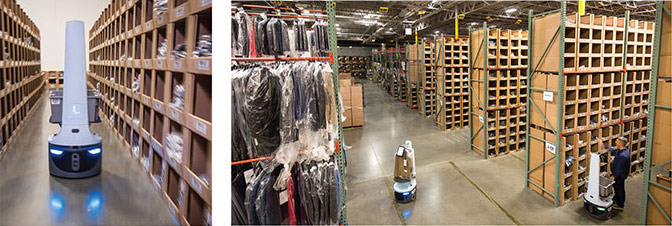
Fulfillment at the edge
Those improvements were made inside the four walls of the two primary distribution centers. But, going faster inside the DC doesn’t shorten the distance between the point of distribution and the customer. That’s increasingly urgent as next day delivery is table stakes for highly populated areas and same day is around the corner.
Some retailers are tackling that by using their brick-and-mortar locations. But, as Brent Beabout, president of Quiet Platforms, points out, ship from store is a tool and not a solution. “Next-day and same-day delivery is a very expensive proposition,” Beabout says. “Ship from store is a way to mitigate, but it’s not a complete solution because stores are limited in the amount of stock and SKUs they carry.” What’s more, using store associates and manual picking is inefficient at scale.
While AEO does offer ship from store, beginning in 2019, it charted a new path. Natarajan and his supply chain team realized they had to position inventory and distribution closer to the customer. Yet AEO couldn’t justify building another 1-million-square-foot campus, or a massive network of micro-fulfillment centers.
Instead, Natarajan partnered with Quiet Logistics, a 3PL that specialized in e-fulfillment for small to mid-size retail brands. In 2021, AEO acquired Quiet Logistics and AirTerra, a transportation platform, and appointed Beabout president of the newly created Quiet Platforms.
The idea of working with Quiet Logistics was to position AEO’s fastest-moving SKUs close to major metropolitan areas by using an in-market network. Currently, eight strategically located buildings are near the Boston area, Dallas, Chicago, Columbus and Los Angeles.
Quiet’s facilities typically measure between 300,000 and 500,000 square feet. As leased facilities, they are designed to be modular, flexible and nimble. Newly received merchandise goes directly to forward pick locations. They use autonomous mobile robots from Locus and 6 River Systems for robot-to-goods picking, and conventional pack stations, with some autobaggers.
While more automation may be in the cards down the road, Beabout says his focus is on building out the technology team. “Software is our secret sauce,” he says. Projects in the works include a merge-in-transit initiative: This would allow packages from several vendors going to the same customer to be consolidated into a single box from Quiet Platforms so the customer receives just one delivery. “It’s not there yet,” says Beabout, “but it could be groundbreaking.”
And, it will do more to speed up AEO’s supply chain, which remains the No. 1 priority. As Glivic notes, “I’m excited about where the business is going. If we connect in another two or three years, it will be a different conversation as we continue to grow our methodology.
In the next article, we’ll share AEO’s vision for “co-opetition,” or a supply chain that is shared by competitors to drive down costs and increase the speed for everyone in the network.

Article Topics
Fulfillment News & Resources
Cardinal Health at-Home Solutions automates from shelf to patient Pan Pacific Pet learns new trick 2024 Warehouse Outlook and Trends Research Brief GEODIS maximizes flexibility and minimizes touches Don’t forget inventory when kick-starting plans Automatic data capture (ADC): Accelerating the process Optimal Parcel Packing For Cost More FulfillmentLatest in Materials Handling
The (Not So) Secret Weapons: How Key Cabinets and Asset Management Lockers Are Changing Supply Chain Operations MODEX C-Suite Interview with Harold Vanasse: The perfect blend of automation and sustainability Consultant and industry leader John M. Hill passes on at age 86 Registration open for Pack Expo International 2024 Walmart chooses Swisslog AS/RS and software for third milk processing facility NetLogistik partners with Vuzix subsidiary Moviynt to offer mobility solutions for warehouses Materials Handling Robotics: The new world of heterogeneous robotic integration More Materials HandlingAbout the Author
Subscribe to Materials Handling Magazine

Find out what the world's most innovative companies are doing to improve productivity in their plants and distribution centers.
Start your FREE subscription today.
April 2024 Modern Materials Handling

Latest Resources


